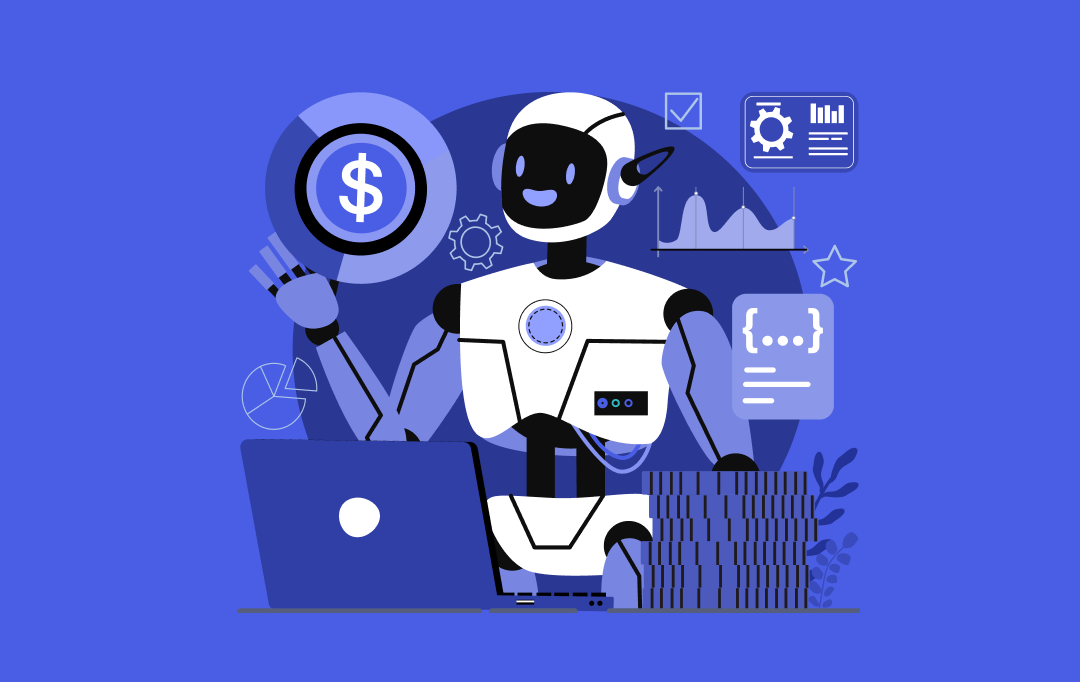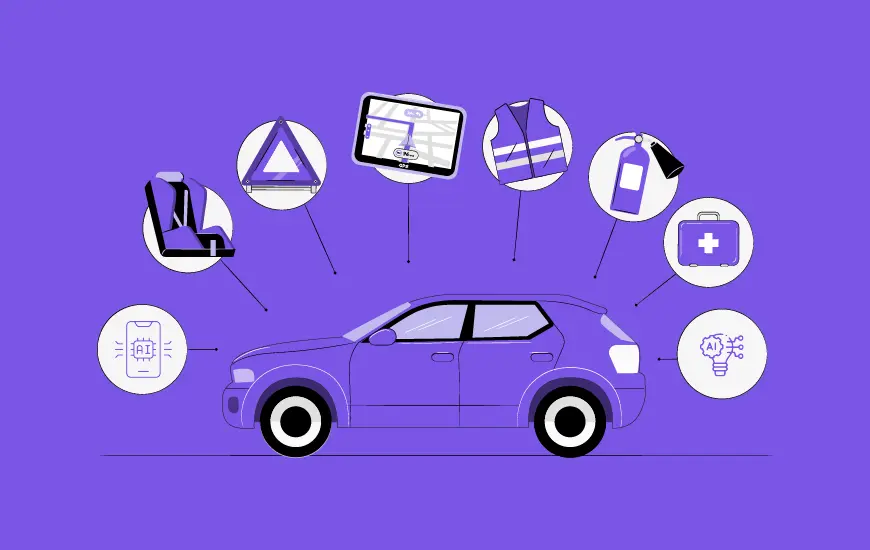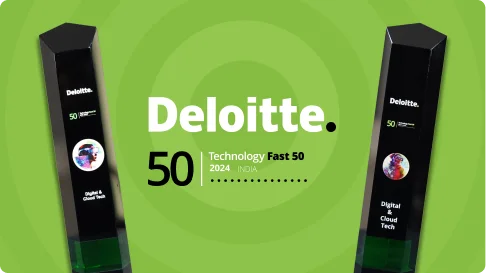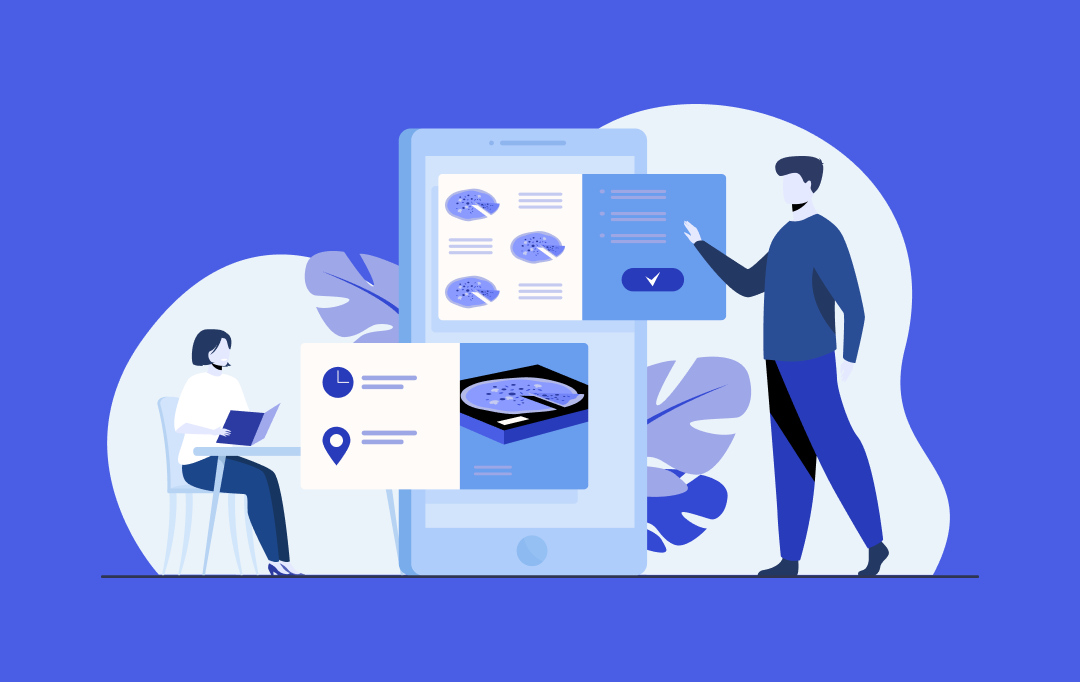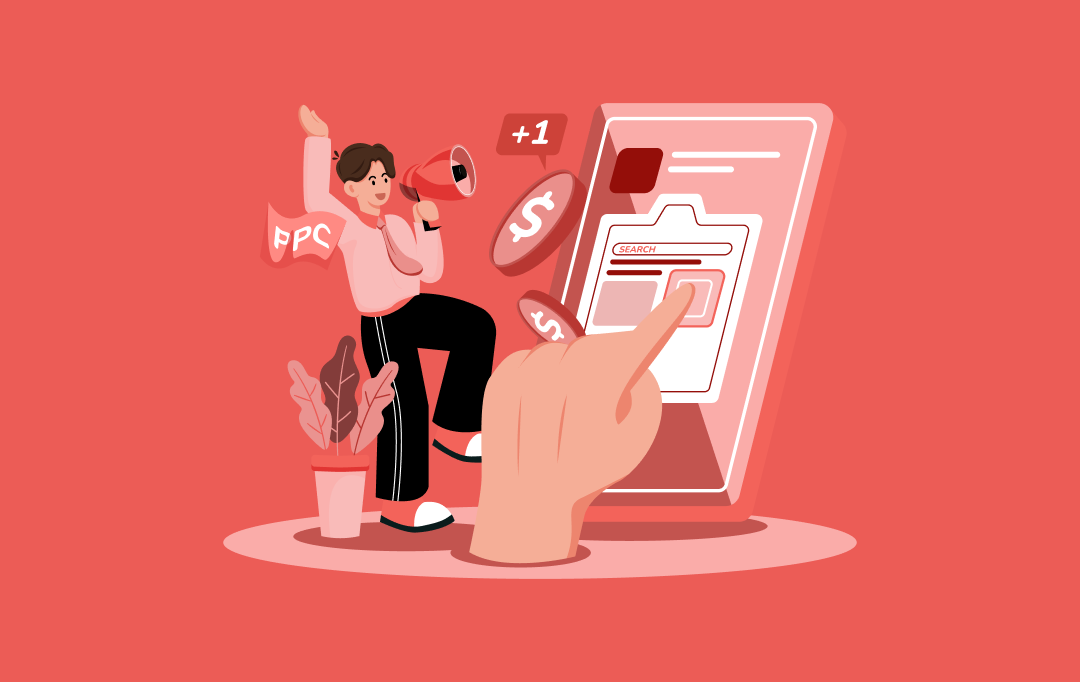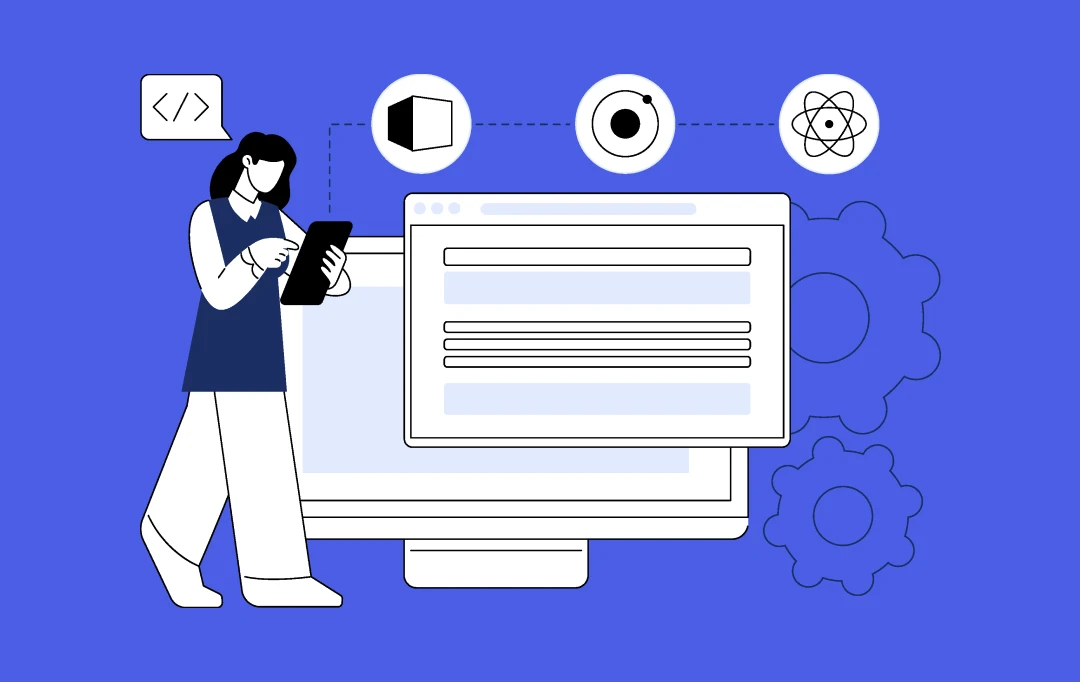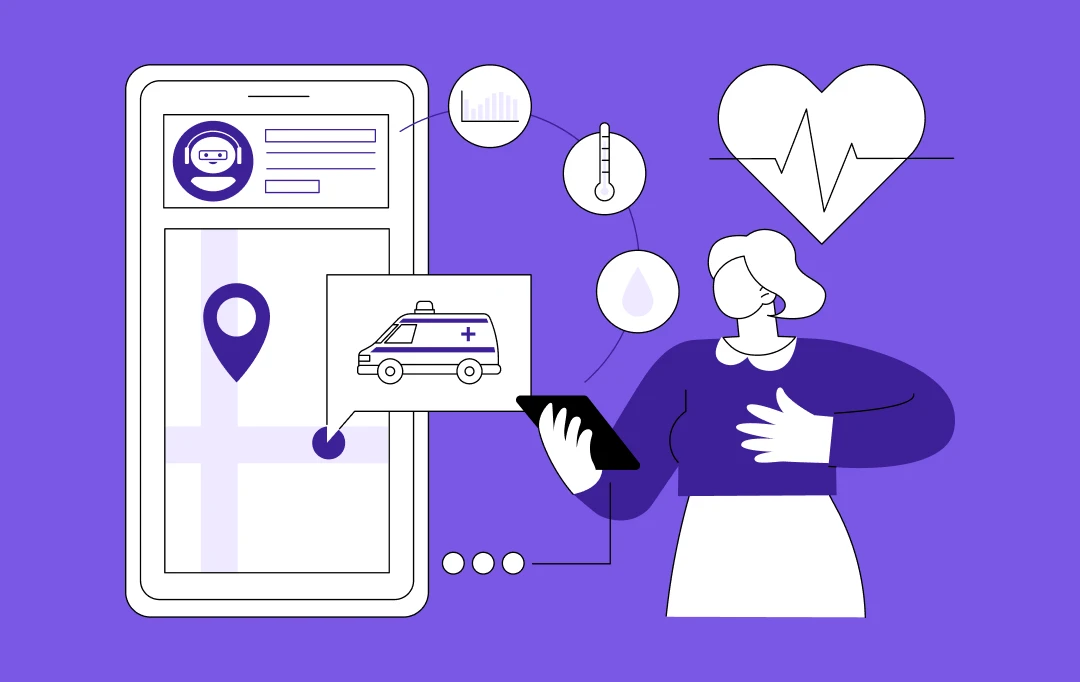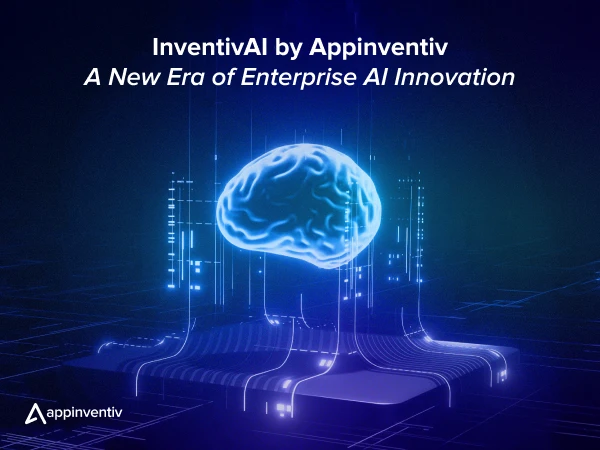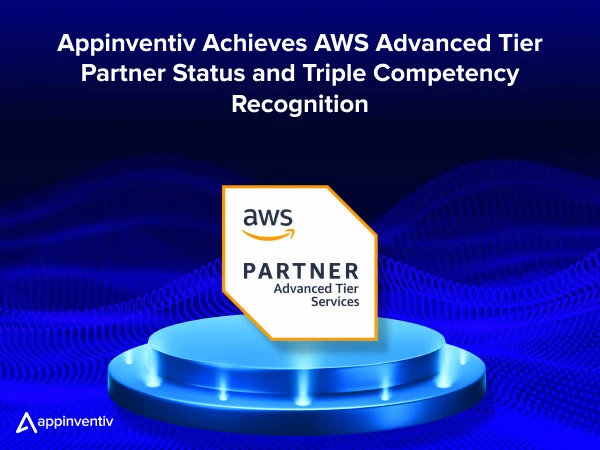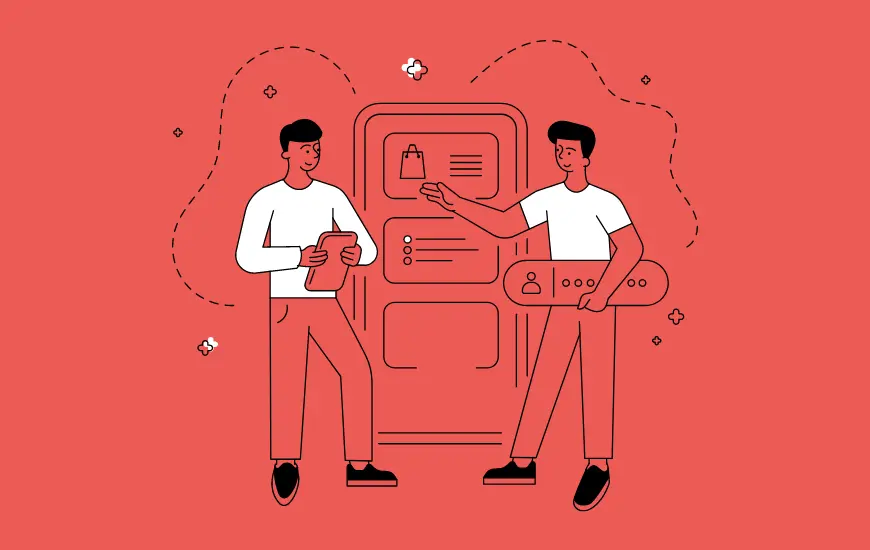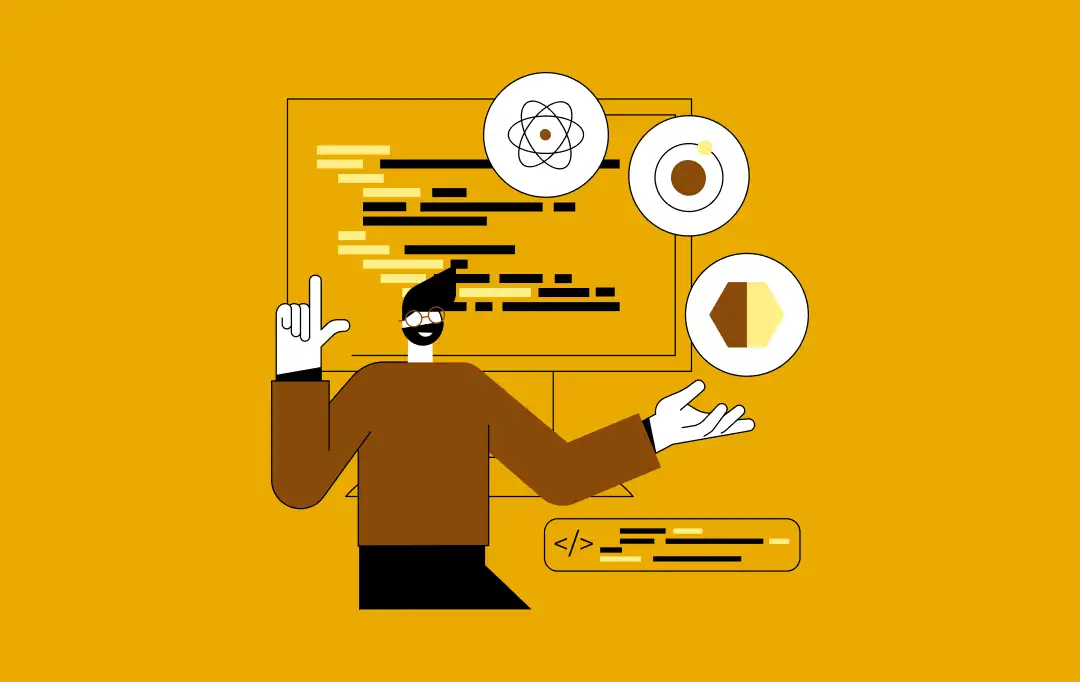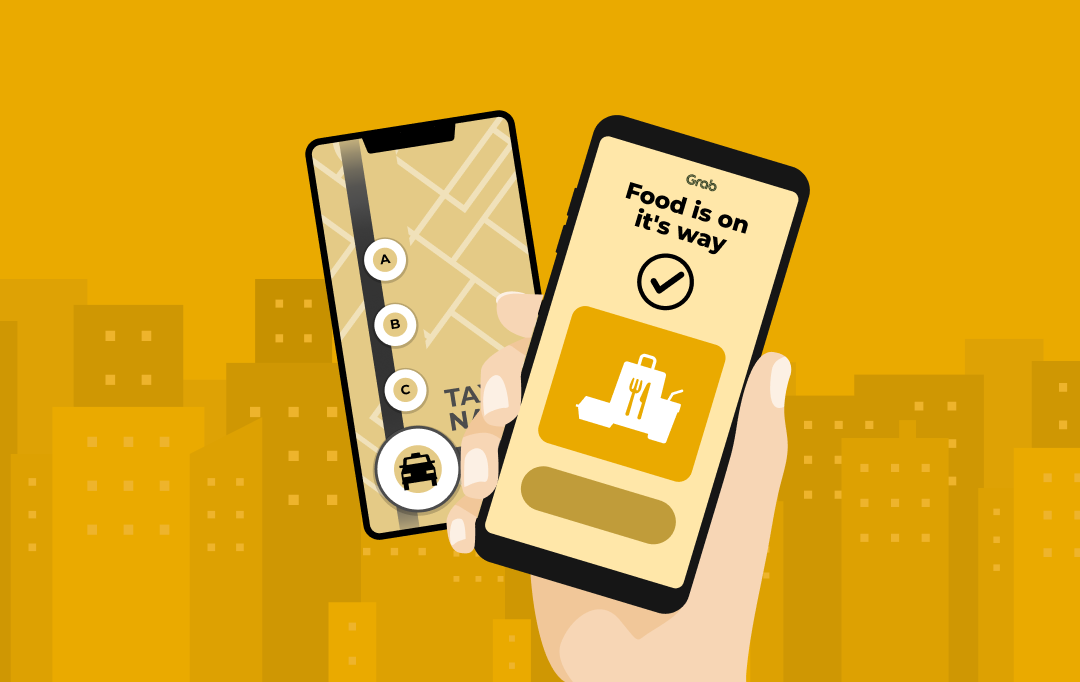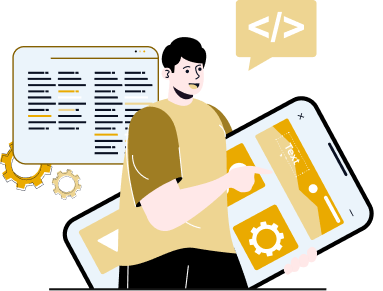- Overview of Grab: The Super App Phenomenon
- A Comprehensive View of the Costs Involved in Developing an App Like Grab
- Development Stage Cost Analysis
- Cost Estimation Formula
- Grab-Like App Development Cost In Singapore (As Per Development Team Size)
- Time and Effort Estimates
- Factors Affecting Grab App Development Cost in Singapore
- Complexity of Design Requirements
- Backend Development Complexity
- Third-party Integrations
- Security and Compliance Measures
- Platform Selection Impact
- Advanced Technology Integration
- Feature Complexity
- Unseen Expenses: Hidden Costs in Developing a Grab-like App
- App Maintenance and Updates (20-25% annually)
- Infrastructure and Hosting Costs
- App Store Fees and Commission
- Marketing and User Acquisition
- Legal and Licensing Expenses
- Effective Strategies to Optimize Your Grab App Development Costs
- Developing an MVP First
- Feature Prioritization Strategy
- Cross-Platform Development
- Strategic Outsourcing
- How to Develop an App Like Grab: A Step-by-Step Guide
- Phase 1: Market Research and Planning
- Phase 2: Design and Prototyping
- Phase 3: Backend Development
- Phase 4: Mobile App Development
- Phase 5: Integration and Testing
- Phase 6: Launch and Optimization
- How to Outperform Grab: Strategies for App Differentiation
- Revenue Model and Monetization Strategies
- Alternative Monetization Strategies
- Dynamic Pricing Models
- Subscription-Based Services
- Data Monetization
- Partnership Revenue
- Why Partner with Appinventiv for Your Super App Development
- FAQs
- Q. What is the cost to build an app like Grab in Singapore?
- Q. How to build an app like Grab in Singapore?
- Q. How long does it take to develop a super app like Grab in Singapore?
- Q. What are the key features of a Grab-like super app?
- Q. What are the benefits of developing an app like Grab in Singapore?
- Q. What are some of the challenges in developing an app like Grab?
- Building a Grab-like app in Singapore requires an investment of $50,000 to $500,000+, depending on features and complexity.
- Grab’s success in ride-hailing and food delivery with a $2.2 billion revenue validates the potential of super apps in Southeast Asia.
- App development costs vary by phase, with backend and core feature development taking up the largest portion of the budget.
- Factors such as design complexity, backend infrastructure, and payment integrations significantly affect the development cost of a Grab-like app.
- Revenue diversification through dynamic pricing, subscriptions, and data monetization is essential for sustainable growth in a super app business model.
Building a super app like Grab is not just a tech endeavor—it’s a strategic move into a $2.7 billion digital opportunity that’s redefining Southeast Asia’s mobile economy. With a model that combines ride-hailing, food delivery, digital payments, and financial services into a single seamless platform, Grab has become a gold standard for super app success in the region.
Its numbers tell a compelling story: over 13 million bookings daily across 8 countries, $2.2 billion in annual revenue, and a 75% market share in Singapore’s ride-hailing sector (Source: Nasdaq). These stats reflect robust market validation and strong consumer demand, underscoring the viability of investing in a similar platform.
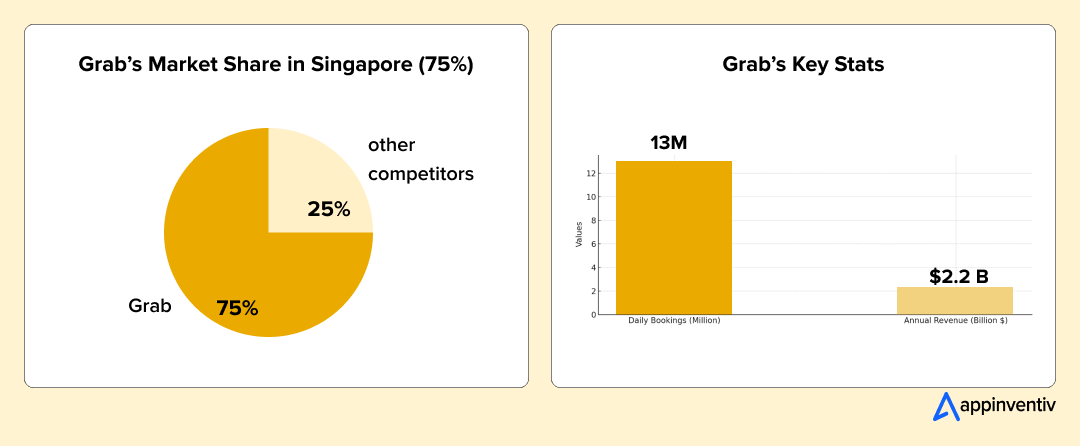
When it comes to estimating the cost to develop a Grab-like app in Singapore, businesses can expect to invest between $50,000 (SGD 67,000) for a basic MVP and upwards of $500,000 (SGD 670,000) for a fully integrated, feature-rich super app capable of operating at scale. The final figure depends heavily on functionality, third-party integrations, design sophistication, and long-term scalability.
Whether you’re planning to build an app like Grab or exploring the viability of super app development, this guide equips you with the data-driven insights necessary to make confident, informed decisions. Inside, you’ll find a comprehensive breakdown of development costs, key factors that influence the overall budget, hidden expenses, proven cost-optimization strategies, step-by-step development guidance, and monetization opportunities.
Let’s dive into a quick overview.
Our team is here to help you develop a powerful, competitive app.
Overview of Grab: The Super App Phenomenon
Grab has evolved from a simple taxi booking platform into Southeast Asia’s most comprehensive super app, fundamentally changing how millions interact with digital services. The platform’s success stems from its ability to integrate multiple service verticals into a single, seamless user experience.
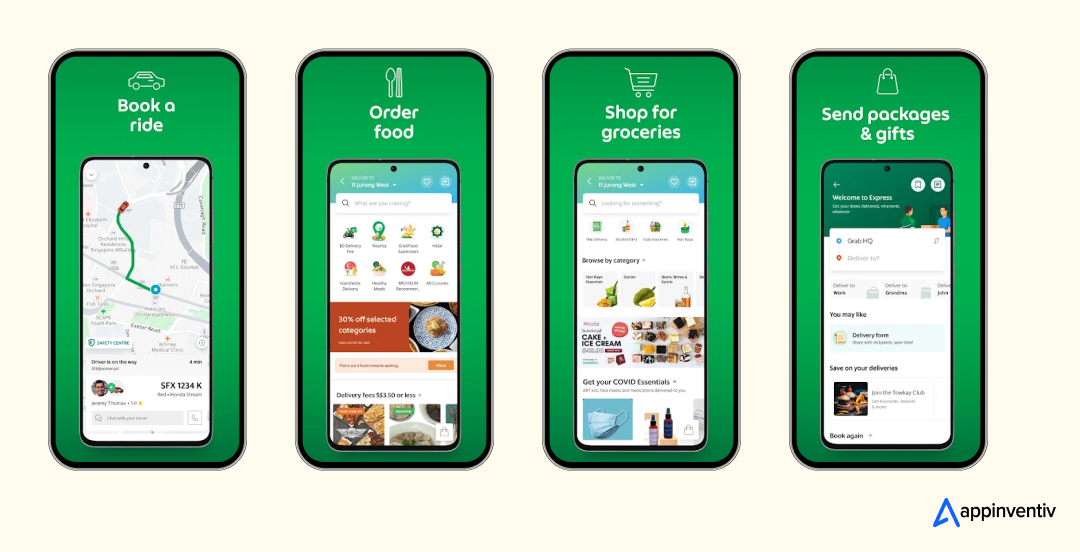
Grab’s financial performance demonstrates the viability of the super app model. The company reported $2.2 billion in gross merchandise value for 2024, with Singapore operations contributing approximately 18% of total revenue.
Monthly active users reached 36.7 million across the platform, with Singapore showing the highest user engagement rates at 4.2 sessions per user daily. (Source: Grab Investor Relations). This level of engagement not only solidifies Grab’s position as a dominant player in Southeast Asia but also demonstrates the continued relevance and success of the super app model in emerging markets.
Again, a recent Reuters article discusses a potential merger between Grab and GoTo, which could result in a combined market share of over 90% in Indonesia and nearly 90% in Singapore. This merger could drive greater efficiency and innovation, creating a more robust platform that benefits consumers with enhanced services and competitive pricing in the Southeast Asian ride-hailing and food delivery markets.
A Comprehensive View of the Costs Involved in Developing an App Like Grab
Understanding the cost to build an app like Grab in Singapore requires analyzing multiple complexity levels and development stages. The investment varies dramatically based on feature scope, technical requirements, and market positioning.
| Complexity Level | Features | Development Time | Cost Range (USD) | Cost Range (SGD) |
|---|---|---|---|---|
| Basic MVP | Single service (taxi OR food), basic UI, simple payment | 4–6 months | $50,000 – $100,000 | SGD 67,000 – SGD 134,000 |
| Intermediate | Dual services, advanced tracking, loyalty programs | 8–12 months | $150,000 – $250,000 | SGD 201,000 – SGD 335,000 |
| Advanced | Multi-service platform, AI features, financial services | 12–18 months | $300,000 – $500,000 | SGD 402,000 – SGD 670,000 |
| Enterprise Scale | Full super app, custom infrastructure, regulatory compliance | 18–24 months | $500,000 – $1,000,000+ | SGD 670,000 – SGD 1,340,000+ |
Development Stage Cost Analysis
Let’s take a closer look at the costs involved in each stage of building an app like Grab. From the initial planning all the way to launch, understanding where your money goes can help you manage your budget more effectively. Breaking it down this way lets you prioritize key areas, optimize your spending, and ensure you get the best value without compromising on quality.
Planning and Research Phase (8-12% of total cost): The foundation phase involves market research, competitor analysis, and technical architecture planning. In Singapore, this typically costs $15,000- $30,000 (SGD 20,100 – SGD 40,200), including user research, regulatory compliance assessment, and technical feasibility studies.
Design and Prototyping (15-20% of total cost): UI/UX for taxi and food delivery apps requires specialized expertise in multi-service platforms. Design costs range from $25,000-$80,000 (SGD 33,500 – SGD 107,200), covering user journey mapping, interface design, and prototype development across iOS, Android, and web platforms.
Core Development Phase (50-60% of total cost): The primary development phase consumes the largest portion of the budget. Backend development, including API creation, database architecture, and server setup, typically costs $100,000-$300,000 (SGD 134,000 – SGD 402,000). Frontend development for native mobile apps adds another $80,000-$200,000 (SGD 107,200 – SGD 268,000).
Integration and Testing (10-15% of total cost): Third-party integrations and comprehensive testing require $20,000-$75,000 (SGD 26,800 – SGD 100,500). This includes payment gateway integration, GPS services, notification systems, and security testing.
Launch and Deployment (5-8% of total cost): The cost to build an app like Grab in Singapore includes a significant allocation for the launch and deployment phase. This covers app store submissions, server deployment, and initial marketing activities, typically ranging between $10,000 and $40,000 (SGD 13,400 – SGD 53,600).
Cost Estimation Formula
Total Development Cost = (Base Development Hours × Hourly Rate) + Third-party Costs + Infrastructure Costs + Contingency (20%)
Grab-Like App Development Cost In Singapore (As Per Development Team Size)
| Role | Hourly Rate (USD) | Hourly Rate (SGD) |
|---|---|---|
| Senior Developer | $80 – $120 | SGD 107 – SGD 161 |
| Designer | $60 – $100 | SGD 80 – SGD 134 |
| Project Manager | $100 – $150 | SGD 134 – SGD 201 |
| QA Tester | $40 – $70 | SGD 54 – SGD 94 |
Time and Effort Estimates
| Development Component | Hours Required | Team Size |
|---|---|---|
| Backend Development | 2,000 – 4,000 | 3 – 5 developers |
| Mobile App Development | 1,500 – 3,000 | 2 – 4 developers |
| UI/UX Design | 800 – 1,500 | 2 – 3 designers |
| Quality Assurance | 1,000 – 2,000 | 2 – 3 testers |
| Project Management | 500 – 1,000 | 1 – 2 managers |
Factors Affecting Grab App Development Cost in Singapore
Several critical factors significantly impact the Grab-like app development cost in Singapore, each requiring careful consideration during project planning, including design complexity, third-party integrations, and platform selection, which all contribute to the overall budget. Here are the top factors to consider:
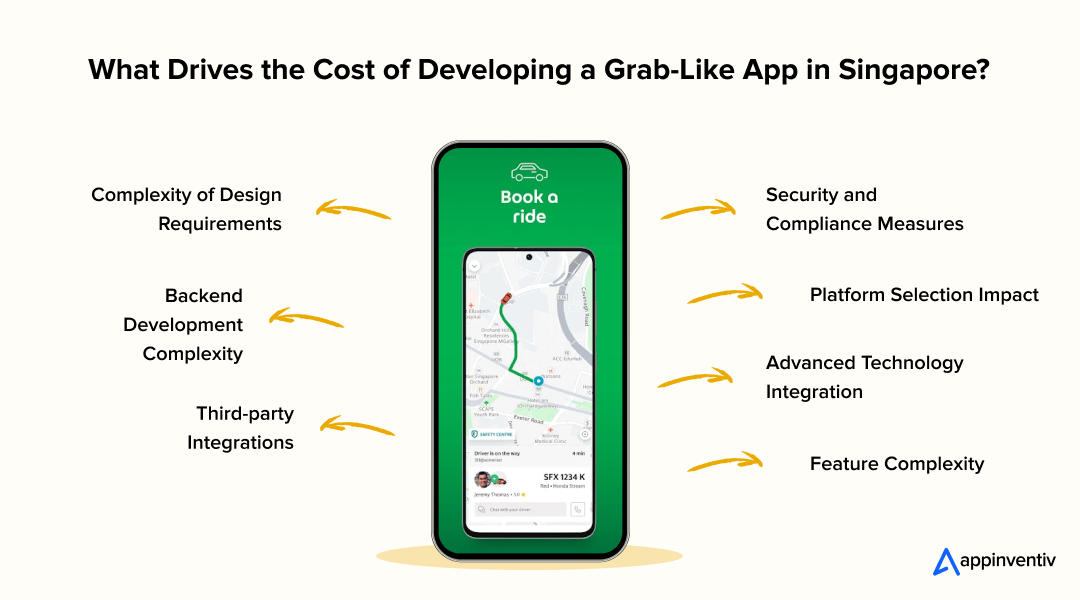
Complexity of Design Requirements
When evaluating the cost to build an app like Grab in Singapore, design complexity plays a critical role. Today’s users expect intuitive navigation, custom animations, micro-interactions, and brand-aligned visual elements. Incorporating multilingual support (English, Mandarin, Malay, Tamil) to cater to Singapore’s diverse market adds to both time and cost.
Such localization efforts can increase design budgets by $15,000–$25,000 (SGD 20,100–33,500). Moreover, integrating adaptive UI for different devices raises the complexity further. Combined, these design expectations can contribute 40–60% of the total design expenditure.
Backend Development Complexity
To build an app like Grab, it is essential to build a powerful backend infrastructure capable of supporting real-time data, dynamic pricing, and multiple user roles. Implementing microservices enables better scalability and resilience, but adds $50,000–$100,000 (SGD 67,000–134,000) to the cost to build an App like Grab in Singapore.
Real-time features, such as live driver tracking and fare calculations, require WebSocket protocols, contributing an additional $20,000–$40,000 (SGD 26,800–53,600). The backend must also seamlessly handle high volumes of user activity. Ultimately, backend development is the backbone of performance and reliability in apps like Grab.
Third-party Integrations
Integrations are a significant cost factor in the Grab-like app development cost in Singapore. Payment systems such as PayNow, GrabPay, and Apple Pay require secure API integrations, which typically cost between $25,000 and $50,000 (SGD 33,500–67,000). Mapping tools like Google Maps or Mapbox come with annual fees of $10,000–$20,000 (SGD 13,400–26,800).
Additional third-party services like SMS gateways, analytics tools, and social login APIs can add another $15,000–$30,000 (SGD 20,100–40,200). While these integrations enhance app functionality and user experience, they must be carefully managed to prevent security vulnerabilities and performance issues.
Also Read: Payment Gateway Integration for Your App
Security and Compliance Measures
Security is non-negotiable, especially given the regulations impacting taxi booking app development cost in Singapore. The app must comply with the Personal Data Protection Act (PDPA), financial guidelines, and transportation-specific laws. Features such as encrypted databases, secure authentication, fraud detection, and GDPR-compliant data processing add $30,000–$60,000 (SGD 40,200–80,400) to the overall cost to build an app like Grab in Singapore.
Compliance also includes periodic audits and legal consultation. Although costly, these elements are essential for avoiding legal risks and ensuring user trust, particularly for apps that handle sensitive data.
Platform Selection Impact
The choice between native and cross-platform frameworks directly affects Grab app development timelines and costs. Native development for both iOS and Android offers top-tier performance and user experience, but almost doubles the development effort and budget.
In contrast, cross-platform technologies like Flutter and React Native reduce costs by 30–40%, though they may struggle with certain advanced features. If time-to-market is critical, hybrid solutions may be preferred. However, platform-specific requirements, such as payment systems or camera APIs, can still drive up complexity, thus adding to the cost to build an app like Grab in Singapore.
Advanced Technology Integration
Emerging technologies add major value and cost to food delivery app development in Singapore. AI-powered systems like route optimization, predictive demand, voice recognition, or chatbot support can raise development budgets by $40,000–$80,000 (SGD 53,600–107,200). These features improve operational efficiency and create a smarter, more engaging user experience.
Integrating machine learning algorithms or recommendation engines also requires specialized expertise. While not always essential at launch, advanced tech significantly enhances scalability and customer satisfaction over time, making it a worthwhile investment.
Feature Complexity
Sophisticated features are a major cost driver in the taxi booking app development cost in Singapore. Real-time tracking, smart pricing algorithms, multiple payment options, and AI recommendations all add to the development timeline.
These features demand deeper backend logic, more rigorous QA testing, and sometimes even third-party partnerships. Custom features can add $30,000–$70,000 (SGD 40,200–93,800), depending on the scope. Entrepreneurs must weigh feature value versus cost to maintain a balance between innovation and budget control in early-stage development.
Unseen Expenses: Hidden Costs in Developing a Grab-like App
Beyond initial development, several ongoing costs significantly impact the total cost to build an app like Grab in Singapore. These hidden expenses, such as app maintenance, infrastructure scaling, and legal compliance, can add up over time. Understanding these costs upfront helps ensure your project stays within budget and meets long-term profitability goals.
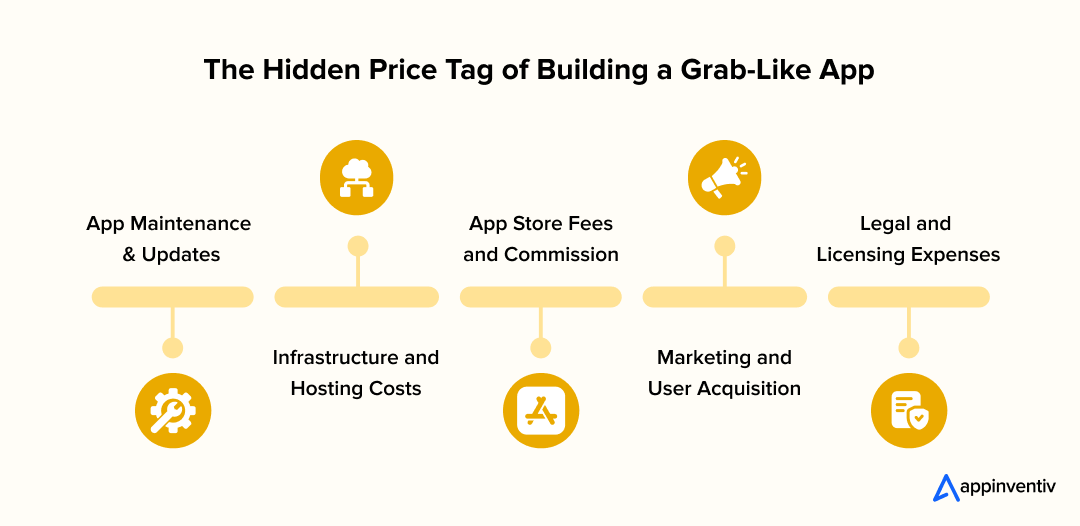
App Maintenance and Updates (20-25% annually)
Post-launch maintenance typically costs 20–25% of initial development expenses annually. For a $200,000 (SGD 268,000) app, expect $40,000–$50,000 (SGD 53,600–67,000) yearly maintenance costs covering bug fixes, security updates, and feature enhancements.
Infrastructure and Hosting Costs
Cloud hosting costs scale with user growth. Initial hosting for 10,000 active users costs approximately $2,000–$5,000/month (SGD 2,680–6,700/month). As usage grows to Grab’s scale, monthly infrastructure costs can reach $50,000–$100,000 (SGD 67,000–134,000).
App Store Fees and Commission
Apple App Store and Google Play Store charge 30% commission on in-app purchases and subscriptions. For payment processing, additional fees of 2.9-3.5% apply to transaction volumes which adds to the overall Grab-like app development cost in Singapore.
Marketing and User Acquisition
Customer acquisition costs in Singapore’s competitive market range from $15–$50 (SGD 20–67) per user for ride-hailing apps and $8–$25 (SGD 11–33.50) for food delivery. Achieving significant market penetration requires substantial marketing investments.
Legal and Licensing Expenses
Ongoing legal compliance, insurance, and licensing fees cost $20,000–$50,000 (SGD 26,800–67,000) annually. This includes business licenses, transport operator permits, and data protection compliance audits.
Effective Strategies to Optimize Your Grab App Development Costs
Smart cost optimization strategies can reduce taxi booking app development cost in Singapore without compromising quality or functionality. These approaches not only help reduce costs but also ensure scalability and long-term success for your app.

Developing an MVP First
Starting with a Minimum Viable Product focusing on core features reduces initial investment by 60-70%. An MVP for taxi booking and food delivery typically costs $50,000-$100,000 (SGD 67,000–134,000), allowing market validation before full-scale development.
Feature Prioritization Strategy
Implementing the 80/20 rule, focusing on 20% of features that provide 80% of user value, significantly reduces development time and costs. Core features should include user registration, service booking, payment processing, and basic tracking.
Cross-Platform Development
Using React Native or Flutter for cross-platform development reduces costs by 30-40% compared to native development while maintaining high performance standards.
Strategic Outsourcing
Leveraging Singapore’s position as a regional hub, companies can optimize costs by combining local project management with regional development teams. This approach reduces costs by 20-30% while maintaining quality standards.
How to Develop an App Like Grab: A Step-by-Step Guide
Developing a Grab-like app involves a meticulous approach, encompassing multiple phases that guarantee successful market entry. Below is a breakdown of each development stage, highlighting the key steps, challenges, and costs involved in creating a robust taxi and food delivery app.

Phase 1: Market Research and Planning
A successful Grab app development project starts with a thorough market analysis. This phase involves studying competitors, identifying opportunities, and understanding user needs. Developing user personas helps tailor the app’s features to target audiences, while prioritizing features ensures that the essential services, like ride-hailing and food delivery, are at the forefront.
Additionally, legal compliance for Grab-like app development in Singapore must be considered, as the app needs to meet all local regulations related to transport services and financial transactions. Planning the app’s technical architecture is also crucial at this stage, ensuring scalability for future growth.
Phase 2: Design and Prototyping
The design phase focuses on creating a seamless user experience. This involves crafting intuitive interfaces that allow users to navigate multiple services easily, whether it’s booking a ride or ordering food. With a focus on visual appeal and ease of use, the design process includes wireframes, UI/UX design, and prototyping.
By testing early prototypes, developers can validate design concepts and make necessary adjustments, preventing costly changes during later stages. Effective food delivery app development in Singapore requires incorporating local design elements to ensure the app resonates with the target audience.
Phase 3: Backend Development
The backbone of any super app, such as Grab, is its robust backend system. This phase focuses on building a scalable infrastructure capable of supporting a variety of services, such as ride-booking, food delivery, and in-app payments.
Real-time features like GPS tracking, push notifications, and dynamic pricing need to be integrated, which requires sophisticated API development and database management. App developers in Singapore to build an app like Grab need to ensure that the backend is designed for future expansion, facilitating the addition of new services as the business grows.
Phase 4: Mobile App Development
Mobile app development is a critical phase in building a Grab-like app. Whether you choose to develop native apps for iOS and Android or use a cross-platform framework, performance and user experience are paramount. Native apps offer the best performance but can be costlier and take longer to develop.
Cross-platform solutions like Flutter or React Native reduce development time and cost by enabling a single codebase for both platforms. During this phase, the app’s design and backend are integrated, ensuring smooth functionality across services.
Phase 5: Integration and Testing
The integration phase ensures that all app components work together seamlessly. This involves connecting the front-end user interface with the back-end infrastructure, including payment gateways, GPS services, and real-time notifications.
Security testing is a vital component at this stage, particularly to validate data protection and ensure that payment processing systems are secure. With legal compliance for Grab-like app development in Singapore, developers must also verify that the app adheres to local regulations on data privacy, financial transactions, and consumer protection.
Phase 6: Launch and Optimization
After the app is fully developed, it’s time to launch it to the public. The launch phase typically begins with a gradual market rollout, allowing the app to be tested by real users. This helps developers gather feedback, identify bugs, and optimize the app based on real-world performance.
Post-launch optimization focuses on fine-tuning the app’s features, fixing any bugs, and scaling the app to accommodate more users. Additionally, the cost to build an app like Grab in Singapore can vary significantly depending on the launch scale and the need for additional marketing campaigns to boost visibility.
How to Outperform Grab: Strategies for App Differentiation
Competing with established platforms like Grab requires strategic differentiation and innovation. By focusing on unique features such as enhanced user experience, advanced technologies, and localized solutions, you can create an app that stands out in the competitive market. These strategies help attract and retain users while offering a superior alternative to current market leaders.
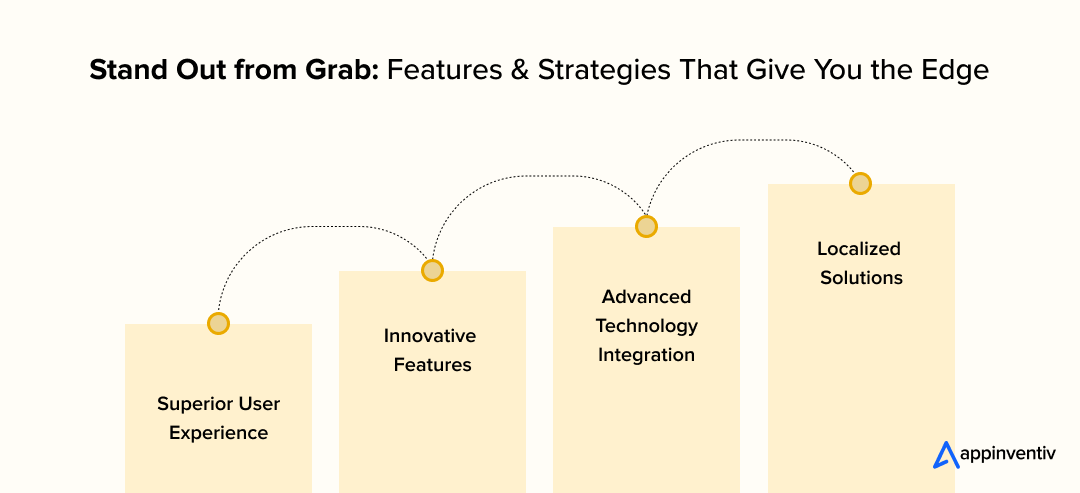
Superior User Experience: Focus on UI/UX for taxi and food delivery apps that eliminate friction points. Implement one-tap booking, predictive ordering, and personalized recommendations to enhance user satisfaction.
Innovative Features: Consider implementing features Grab doesn’t offer: subscription-based unlimited rides, carbon footprint tracking, community ride-sharing, or integration with smart city infrastructure.
Advanced Technology Integration: Leverage emerging technologies like augmented reality for navigation, IoT integration for smart pickup points, or blockchain for transparent pricing and reviews.
Localized Solutions: Deep local market understanding can provide competitive advantages through culturally relevant features, partnerships with local businesses, and integration with local payment methods.
With tailored features and cutting-edge technology, we’ll help you build an app that stands out.
Revenue Model and Monetization Strategies
Understanding Grab’s business & revenue model provides insights for developing sustainable monetization strategies. By examining how Grab generates revenue through multiple streams, such as ride-hailing, food delivery, and mobile payments, you can identify opportunities for diversification. This helps in building a comprehensive strategy that ensures long-term profitability and scalability for your app.
Grab’s Current Revenue Streams
| Revenue Stream | Contribution | Mechanism |
|---|---|---|
| Ride-hailing Commission | 35-40% | 20-25% commission per ride |
| Food Delivery Commission | 25-30% | 15-30% commission + delivery fees |
| Financial Services | 20-25% | Transaction fees, lending interest |
| Advertising | 10-15% | Merchant advertising, sponsored listings |
| Subscription Services | 5-10% | GrabUnlimited, premium memberships |
Alternative Monetization Strategies
Exploring monetization methods for Grab App allows you to diversify revenue sources beyond traditional ride-hailing and delivery services. Implementing strategies like subscription models, dynamic pricing, or data monetization can enhance profitability and provide sustainable long-term growth for your platform. Let’s have a closer look at those.
Dynamic Pricing Models
Implement surge pricing during peak hours, generating higher revenue per transaction while managing demand. By adjusting pricing in real-time based on demand and supply, you can ensure that your app maximizes profitability during peak periods. For a taxi and food delivery app in Singapore, this model is particularly effective due to the region’s high demand for transportation and food delivery services.
Subscription-Based Services
Offer unlimited rides or delivery services for monthly fees, providing predictable revenue streams and increased user loyalty. Subscriptions can be tiered, offering different levels of service (e.g., premium customers receiving faster service or discounts). By promoting subscriptions, you build a steady revenue base, which helps with cash flow management and reduces reliance on per-transaction income.
Data Monetization
Anonymized user behavior data provides valuable insights for urban planning, retail analytics, and market research, creating additional revenue opportunities. This data can be sold to third parties like research firms, local businesses, or governments interested in consumer patterns, travel behavior, and delivery trends. By aggregating non-personalized data, you can generate passive income while safeguarding user privacy and ensuring regulatory compliance.
Partnership Revenue
Strategic partnerships with hotels, malls, and entertainment venues can generate referral fees and cross-promotional opportunities. By offering users exclusive discounts or deals when they visit these partnered locations through your app, you not only enhance user experience but also create a new revenue stream. Partnerships with local businesses can also increase your app’s visibility and attract more users through joint marketing campaigns.
Also Read: How Do Apps Make Money: Strategies to Boost Your Revenue Potential
Why Partner with Appinventiv for Your Super App Development
At Appinventiv, we understand that food delivery app development in Singapore and ride-hailing platforms require more than technical expertise—they demand deep market insights, regulatory knowledge, and proven scalability solutions.
Our team has delivered over 200 mobile applications, including several multi-service platforms similar to Grab. We specialize in creating scalable architectures that support rapid user growth while maintaining optimal performance and security standards.
As a leading mobile app development company in Singapore, we have an in-depth understanding of local regulations, market trends, and user preferences. Our team delivers end-to-end development services, guiding you from initial concept and design to market launch and continuous optimization, ensuring your app meets the highest standards of quality and performance.
Our Proven Approach: We begin every project with comprehensive market research and technical planning, ensuring your investment delivers maximum ROI. Our agile development methodology provides regular progress updates and flexibility to adapt to changing requirements.
Talking about agile mobile app development, we enhanced the Toki daily service platform by adding innovative features that enable seamless booking for taxis, food delivery, and utility payments—all within a single app.
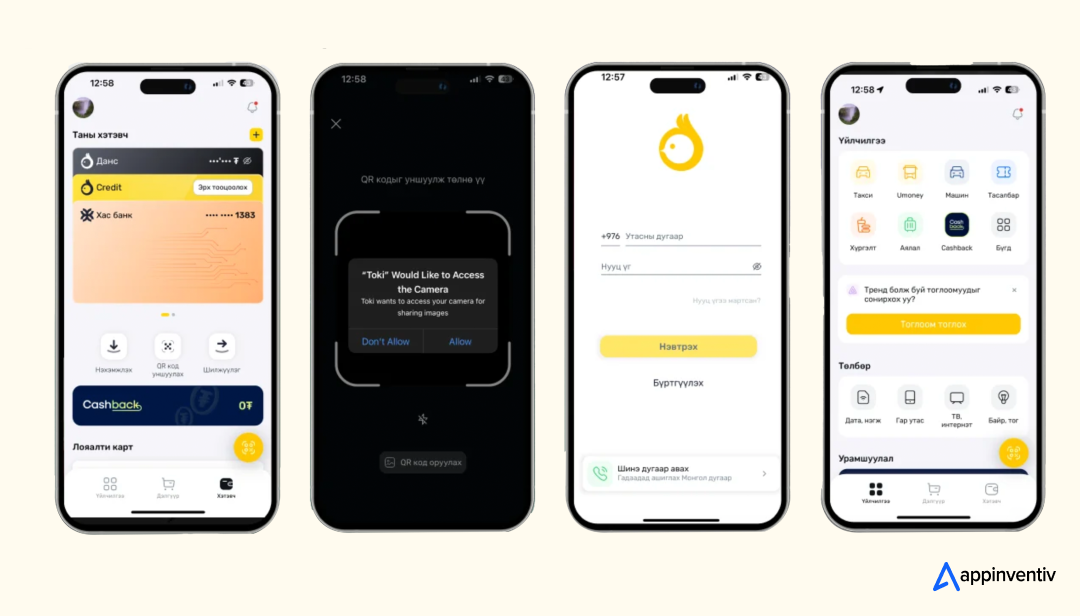
This all-in-one platform improved user convenience and engagement, leading to impressive results. The total active user count increased by 157,000, and the number of app downloads grew by 782,000, reflecting the platform’s rising popularity and market success.
Impressive Portfolio: We’ve partnered with global food giants like KFC, Domino’s, and Pizza Hut, as well as mobility platforms like Toki and Moo—empowering them with scalable, high-performance apps that enhance user experience and drive business growth.
Technical Excellence: Our developers are experts in the tech stack for taxi and food delivery app development, including microservices architecture, real-time data processing, and advanced security implementations required for financial transaction processing.
Get in touch with us to get started with your Grab-like app development!
FAQs
Q. What is the cost to build an app like Grab in Singapore?
A. The cost to build an app like Grab in Singapore varies significantly depending on factors like complexity, features, and the chosen development approach. Typically, for a Grab-like app development, the cost can range from $50,000 to $500,000 (SGD 67,000 to SGD 670,000).
This estimate includes the design, backend development, integration of third-party services (such as payment gateways and GPS), and ongoing maintenance. Advanced features like real-time tracking and AI integration can further elevate the cost.
Still confused about the Grab-like app development cost in Singapore? Connect with our experts to get a detailed cost estimate.
Q. How to build an app like Grab in Singapore?
A. To build an app like Grab, you need to follow a structured approach that includes comprehensive market research, careful planning of core features, and choosing the right tech stack. Start by defining user personas and app requirements. After this, focus on designing an intuitive UI/UX, followed by backend development to handle services such as ride-hailing, food delivery, and payments.
Grab app development in Singapore should also consider local regulatory compliance and payment integration, ensuring it meets both user expectations and legal standards.
Q. How long does it take to develop a super app like Grab in Singapore?
A. Developing a super app like Grab in Singapore typically takes between 6 to 12 months, depending on the app’s complexity. The development timeline includes stages like market research, design, backend and mobile app development, integration of third-party services, and rigorous testing.
The more advanced features you incorporate, like real-time tracking, AI-driven recommendations, and mobile payments, the longer the development cycle. A well-executed Grab app development project should enable iterative updates post-launch to improve functionality based on user feedback continuously.
Q. What are the key features of a Grab-like super app?
A. A Grab-like super app includes a diverse set of features, based on its three different panels, all designed to enhance user convenience and engagement. Key features of a super app like Grab include:
User Panel Features
- User Account Management
- Multi-Service Platform Integration
- Real-Time Tracking & Notifications
- Payment Integration
- Multi-Language & Currency Support
- Dynamic Pricing Models
- Ratings & Reviews
Driver/Delivery Partner Panel Features
- Driver/Delivery Partner Interface
- Real-Time Tracking & Notifications
- Dynamic Pricing Models
- Ratings & Reviews
- Earnings Tracker
- In-App Navigation
- Job Notifications & Acceptance
Admin Panel Features
- Admin Dashboard & Analytics
- User & Partner Management
- Financial Management & Reporting
- Security Features
- Customer Support & Issue Management
- AI-Powered Features (Route Optimization, Demand Forecasting)
- Fraud Detection & Prevention
Q. What are the benefits of developing an app like Grab in Singapore?
A. Here are some of the top benefits of developing an app like Grab in Singapore:
- High Market Demand: Singapore has a well-developed infrastructure and a tech-savvy population that embraces on-demand services like ride-hailing and food delivery.
- Revenue Diversification: By offering multiple services (taxi booking, food delivery, and payments), you can create multiple streams of revenue, increasing overall profitability.
- Scalability: A Grab-like app can easily scale across different services and regions, expanding its reach and increasing market share.
- User Retention: The convenience of multiple services under one platform fosters user loyalty, encouraging them to use the app for various needs.
- Competitive Edge: With the right features and local customization, such as payment integrations and multi-language support, your app can stand out in the competitive Singapore market.
Q. What are some of the challenges in developing an app like Grab?
A. With a number of benefits, there come numerous challenges in developing an app like Grab. Here are some of them with their potential solutions:
- Regulatory Compliance
Challenge: Meeting the stringent legal requirements in Singapore, such as the Personal Data Protection Act (PDPA), can be complex.
Solution: Work closely with legal advisors to ensure compliance with local laws, including data privacy regulations, and ensure that the app adheres to industry-specific standards like financial services or transport authority requirements. - High Development Costs
Challenge: Developing a Grab-like app requires significant investment in features, technology, and integration.
Solution: Start with an MVP (Minimum Viable Product) to keep initial costs low. Prioritize core features and iterate based on user feedback to minimize upfront expenses. - User Acquisition and Retention
Challenge: Attracting users and ensuring they keep using the app amidst competition can be difficult.
Solution: Focus on building a great user experience, offering incentives like discounts, loyalty programs, and localizing the app to cater to specific needs. Regular updates and personalized features also boost engagement. - Backend Infrastructure
Challenge: Building a robust backend that can handle multiple services (taxi booking, food delivery, payments) efficiently, especially when scaling.
Solution: Invest in scalable cloud solutions (e.g., AWS, Google Cloud) and implement microservices architecture to ensure flexibility and scalability as the app grows.


- In just 2 mins you will get a response
- Your idea is 100% protected by our Non Disclosure Agreement.
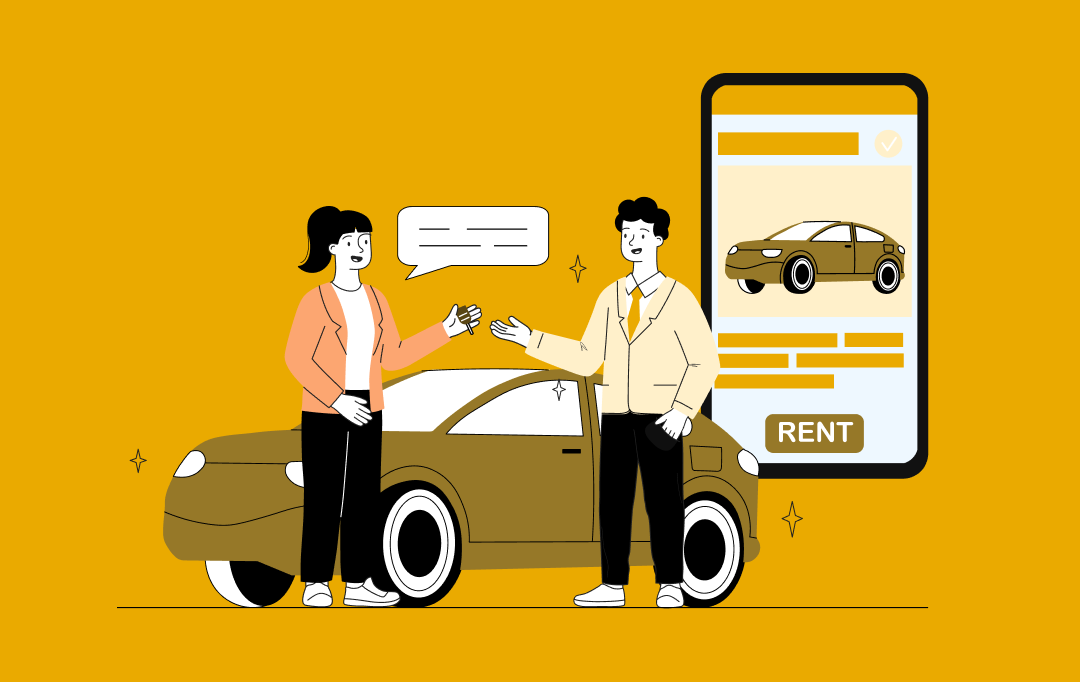
How Much Does It Cost to Build a Car Rental App like Hertz?
Key takeaways: The cost to build a Hertz-like app ranges roughly $40,000–$300,000+. Complexity, automation, and scale matter more than just the number of features. Real costs continue after launch: infra, maintenance, support, and compliance. Smart planning and MVP-first approach help keep budgets under control. Revenue comes from rentals, add-ons, subscriptions, partnerships, and fleet sales. You…

How Much Does It Cost to Build a Banking App like Barclays?
Key takeaways: Barclays sets the bar: Its speed, security, and money management tools show what EU users expect from modern banking apps. Costs vary a lot: A basic, compliant app can start around $40,000 (≈€30,000), while a feature-rich build can reach $400,000+ or more (≈€298,000+). Rules add real work: Meeting PSD2, GDPR, and instant payment…
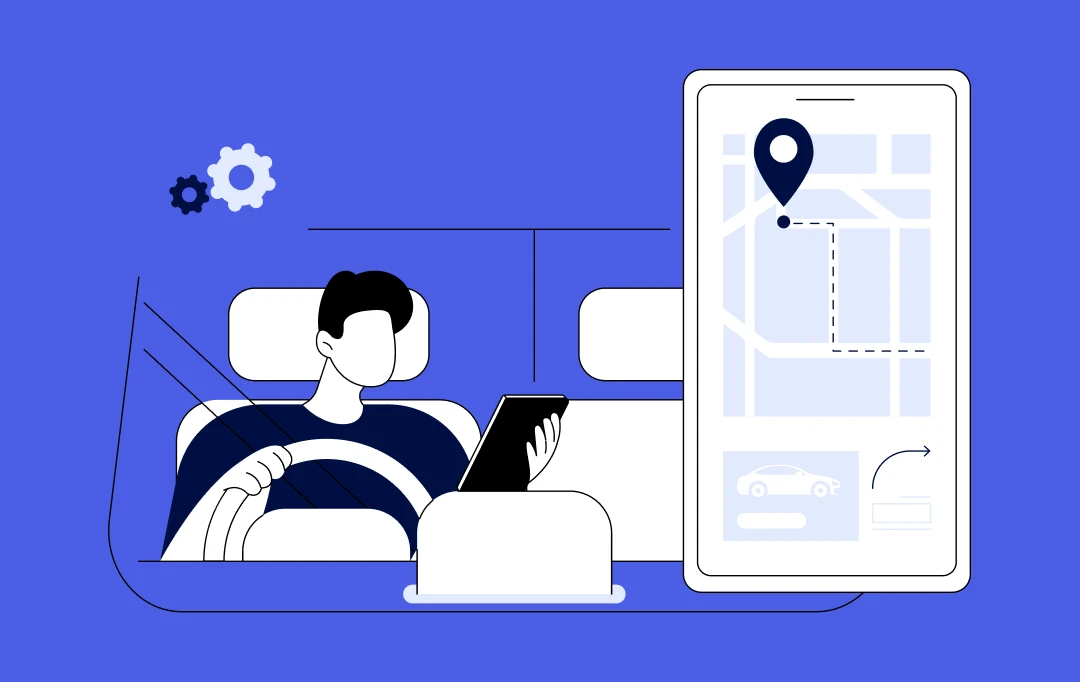
How Much Does It Cost to Build a Route Planning App Like Komoot
Europe doesn’t just love the outdoors- it thrives on it. From the Alps to Amsterdam’s bike lanes, cycling and hiking fuel an industry worth $53.3 billion in 2024, projected to grow at nearly 11% CAGR through 2033, as reported by GrandViewResearch. And leading this charge is Komoot, the route-planning app trusted by 40+ million users.…
